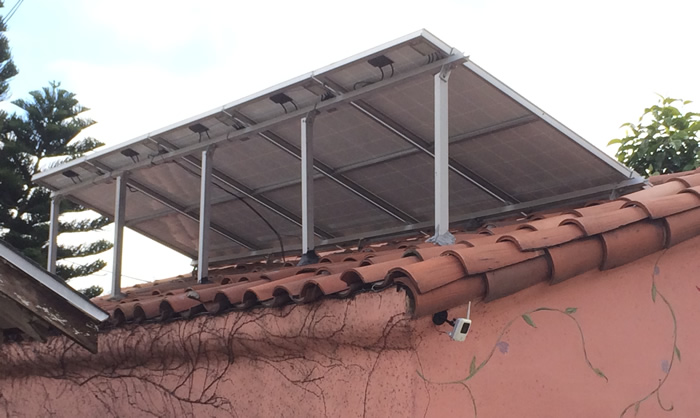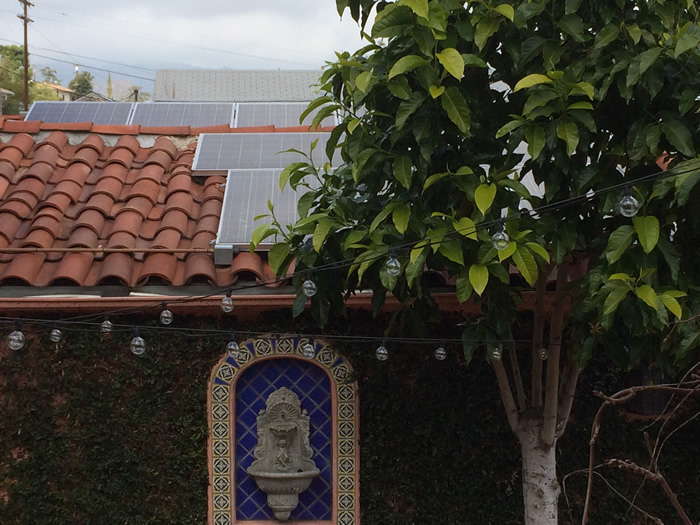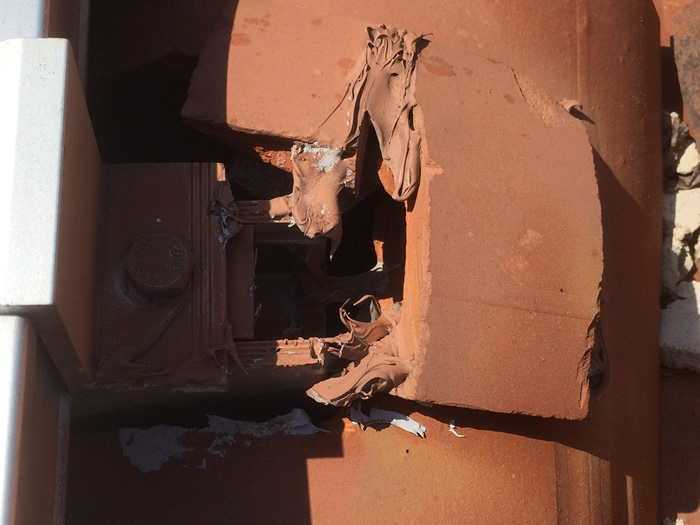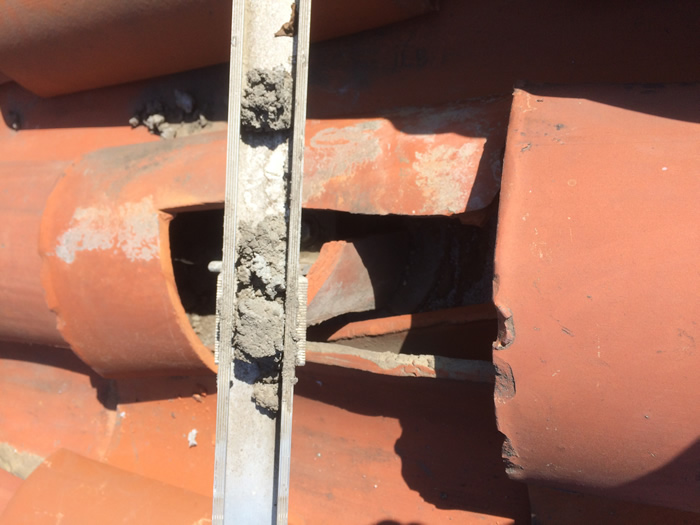Category: "Shortcut Solar"
04/25/19
Shortcut Solar Specialty: Roof Leaks!
While those crazy folks over at Shortcut Solar have many distinguishing characteristics, certainly one of the most commonly displayed is just plain shoddy work—and one of the most devastating consequences of shoddy work is a leaky roof. Check out our latest tale of cleaning up after Shortcut Solar…
We recently got asked to give a homeowner a quote for removing an existing solar installation from her garage because the roof was leaking and needed to be replaced. (The array was there when she purchased the home.) Here’s what we found when we got there: ten panels, installed in a way that only Shortcut Solar could do, check it out…
Ah yes, everyone’s favorite mounting method—not!—reverse tilt on a north sloping roof! Never mind that you are voiding the warranty from the racking manufacture, and putting tremendous strain on all of the components, but heck, it lets you get the panels in more or less the same plane as the south facing panels, right? Oh, and note the “flashing” method at the base of those columns: cement (and/or mastic), well known for its ability to flex with the torque forces that the wind will exert on this “solar wing” that they have fabricated.
But wait, that’s not all, check out the fate of the south facing panels…
Yep, they actually put the array behind a tree! (The homeowner told us that there had been a similar tree on the left of the fountain, but it died after the array was installed.) Truly the folks at Shortcut Solar were on a roll that day!
So, sadly, we set out to remove the array in advance of the roofer coming in to do their thing. (The homeowner generously donated the used equipment to a local city college to assist students in their PV classes.)
The details up on the roof were really appalling. Check this out:
That is an end clamp, attached to a rail that is actually below the level of the tile! The tile above it was “notched” but nothing, at least by now, was in place to keep water from pouring under the broken tile. (The little bit of red mastic is a nice, esthetic, touch!)
Or how about this thing of beauty: actually, it is kinda hard to know what they were thinking here. I can only presume from the concrete in the rail, that they tried to anchor a piece of tile above this, but failed completely.
The panels on the south face were not as awful (apart from being behind a tree), as they had removed the tiles in the area where they were doing their attachments and put down a torch-down layer of roofing material. But even then they could not be consistent–their single bolt attachments in some places had a 3″ lag screw, but in other areas they couldn’t be bothered and simply used a 1½” hex screw. ‘Cause, yeah, why would you care about actually getting into the rafters?
There can be no doubt that this installation was doomed from the day it was installed, and I hate giving such bad news to nice people like this homeowner.
This was in the City of Los Angeles – how on earth did this ever pass inspection? Sadly, with Shortcut Solar on the job, this is the type of work you can expect.
It doesn’t have to be like this. Building inspectors should crack down on this sort of nonsense. And potential solar purchasers need to do their homework better as well. Don’t just go with the smooth talker who shows up on your doorstep - he might be working for Shortcut Solar! Check out reviews, look for NABCEP certification, and talk to past customers. Together we can make Shortcut Solar, and their shoddy work, a thing of the past!
02/20/19
Meet Shortcut Solar!
 Run on Sun has been in the solar business for a long time - since 2006, to be precise. And over the years we have come across a lot of - shall we say - less than inspiring things. Shoddy work. High pressure sales tactics. Contracts not in the customer’s native language. And on and on. So we finally decided enough is enough, it is time to call these people out, and name names!
Run on Sun has been in the solar business for a long time - since 2006, to be precise. And over the years we have come across a lot of - shall we say - less than inspiring things. Shoddy work. High pressure sales tactics. Contracts not in the customer’s native language. And on and on. So we finally decided enough is enough, it is time to call these people out, and name names!
So let me introduce you to… Shortcut Solar. For the purposes of this blog, we have decided that Shortcut Solar is the perfect generic descriptor/catchall to highlight the awful things that we see.
Our tone is intended to be somewhat light-hearted in the hope that these posts will help consumers to be better educated when it comes to researching their options for going solar.
A Shortcut Solar Favorite - the Promise that is Just too Good to be True!
Shortcut Solar knows that they won’t win your business honestly, so they specialize in making stuff up! Case in point: we had a potential client forward to us a proposal that they had received from Shortcut Solar. The proposal conveniently included the contract, so the consumer didn’t need to waste any time signing on the dotted line! (Oh, by the way, that one-page disclosure that is now supposed to be on the front of all solar contracts in California, yeah, it was nowhere to be seen. Way to go, Shortcut Solar!)
Glancing over the proposal, one number jumped off the page, cumulative savings after twenty-five years of $331,000!!! Say what? This is a resi project (oversized at nearly 13 kW, another classic Shortcut Solar move), so how on earth could they come up with such an astronomical number? Lurking in their assumptions was the key - they were predicting annual utility cost increases of 13%! To put this in perspective, we use an annual increase of 3%.
We decided to mock this up using our proposal generation tool, the fabulous Energy Toolbase, but guess what? You can’t, because their tool rejects any value greater than 6% - less than half of what Shortcut Solar was using. (Energy Toolbase prides itself on doing things in an honest and transparent manner - no wonder Shortcut Solar doesn’t use them!)
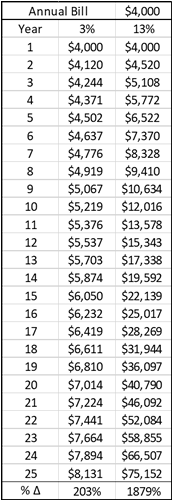 So that meant a quick trip to Excel.
So that meant a quick trip to Excel.
The potential client in question had an annual bill of around $4,000 in SCE territory. The table at left tracks the growth of your annual bill if the escalation rate is 3% (what we would use) versus 13% (what Shortcut Solar was using). For those of us who recall (the original) Mary Poppins, this is a table that would thrill the cold cockles of Mr. Dawes, Sr.’s heart as it shows the power of compound interest!
That $4,000 utility bill, growing at 3% each and every year, will slightly more than double to be $8,131 after twenty-five years. But that is a slacker number if you are Shortcut Solar! Use their magical, mythical 13% and that bill will grow almost 19 times - to an eye-popping $75,000!!! Now that is a number from which you can derive some staggering savings!
The problem, of course, is that it is a lie. And as even recovering trial lawyers like to say: if they lied to you about one thing, how many other things that they have told you are lies?
Frankly, the entire area of financial projections is fraught. The utilities, particularly the investor-owned utilities like SCE, are doing everything that they can to erode the value of your solar investment (which is why the Solar Rights Alliance is so vital), and projecting utility rates over twenty-five years is a fool’s errand.
The best anyone can do is to use the best tools available, and apply reasonable parameters (3% not 13%), over a reasonable period of time (our projections only run 20 years, not the 25 used by Shortcut Solar).
Consumer Takeaway
So here is your consumer takeaway: Look that proposal over carefully, and if those numbers seem too good to be true, you just might be dealing with Shortcut Solar!
Have your own Shortcut Solar story? Let us know and we will add it to the collection!
